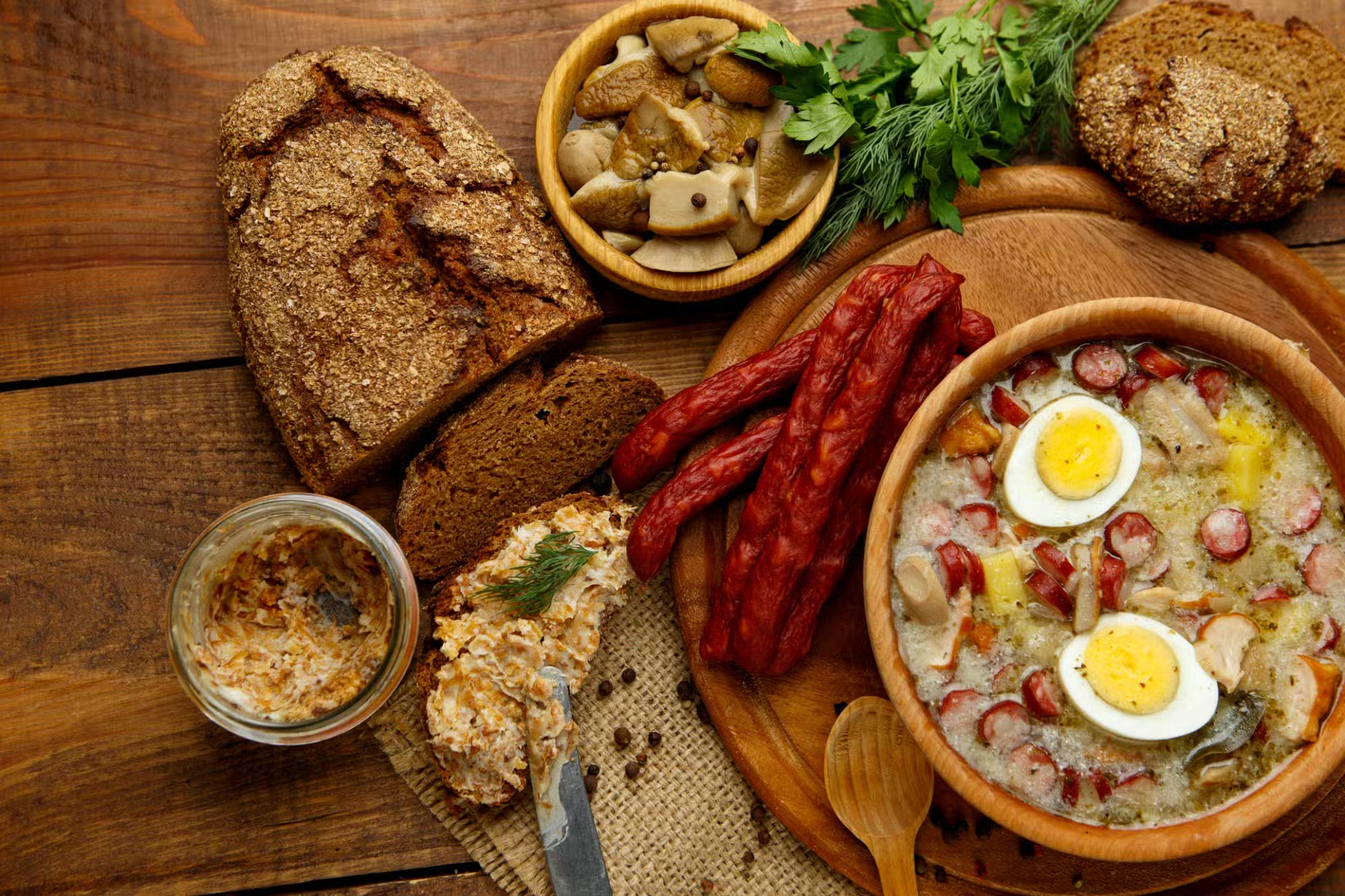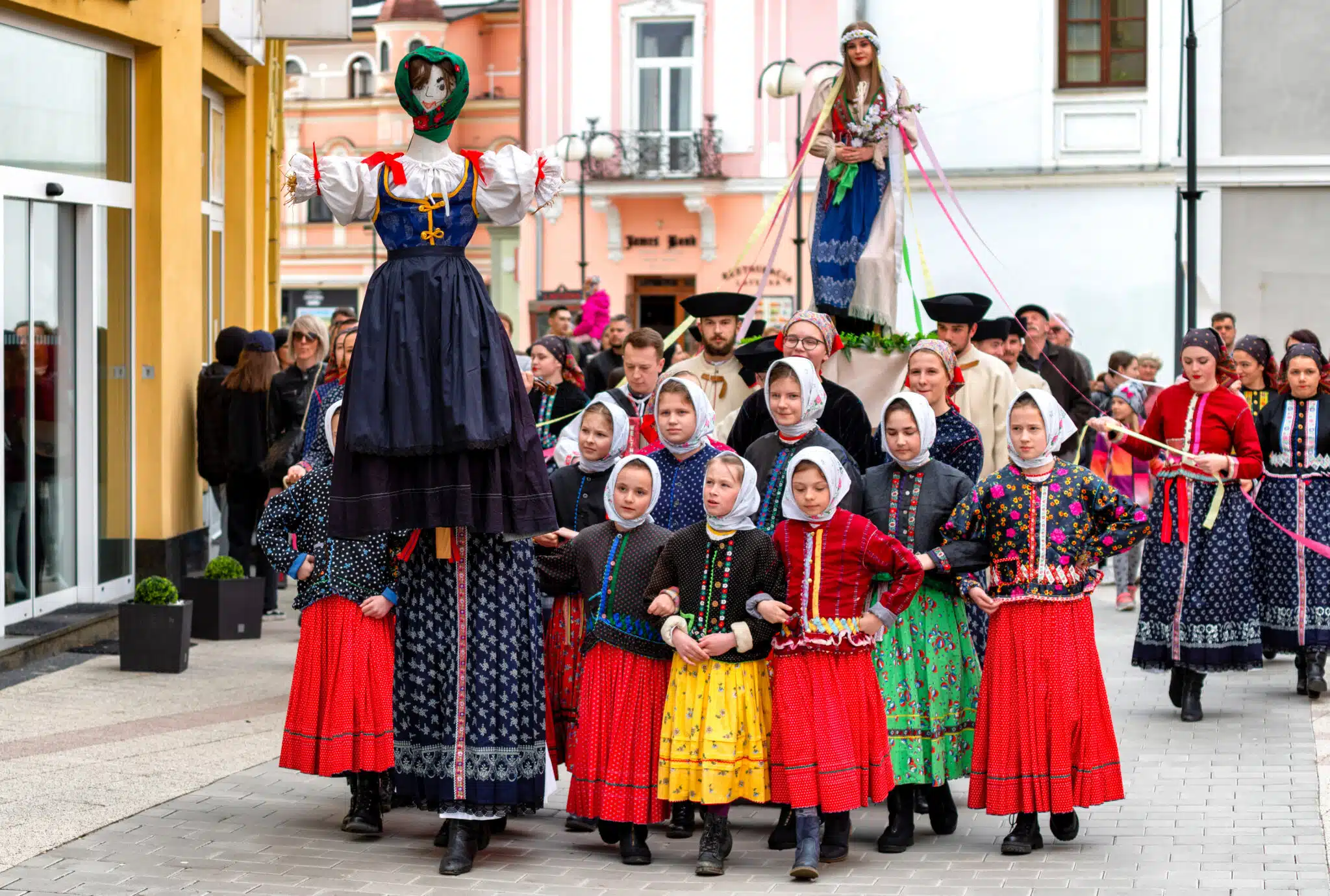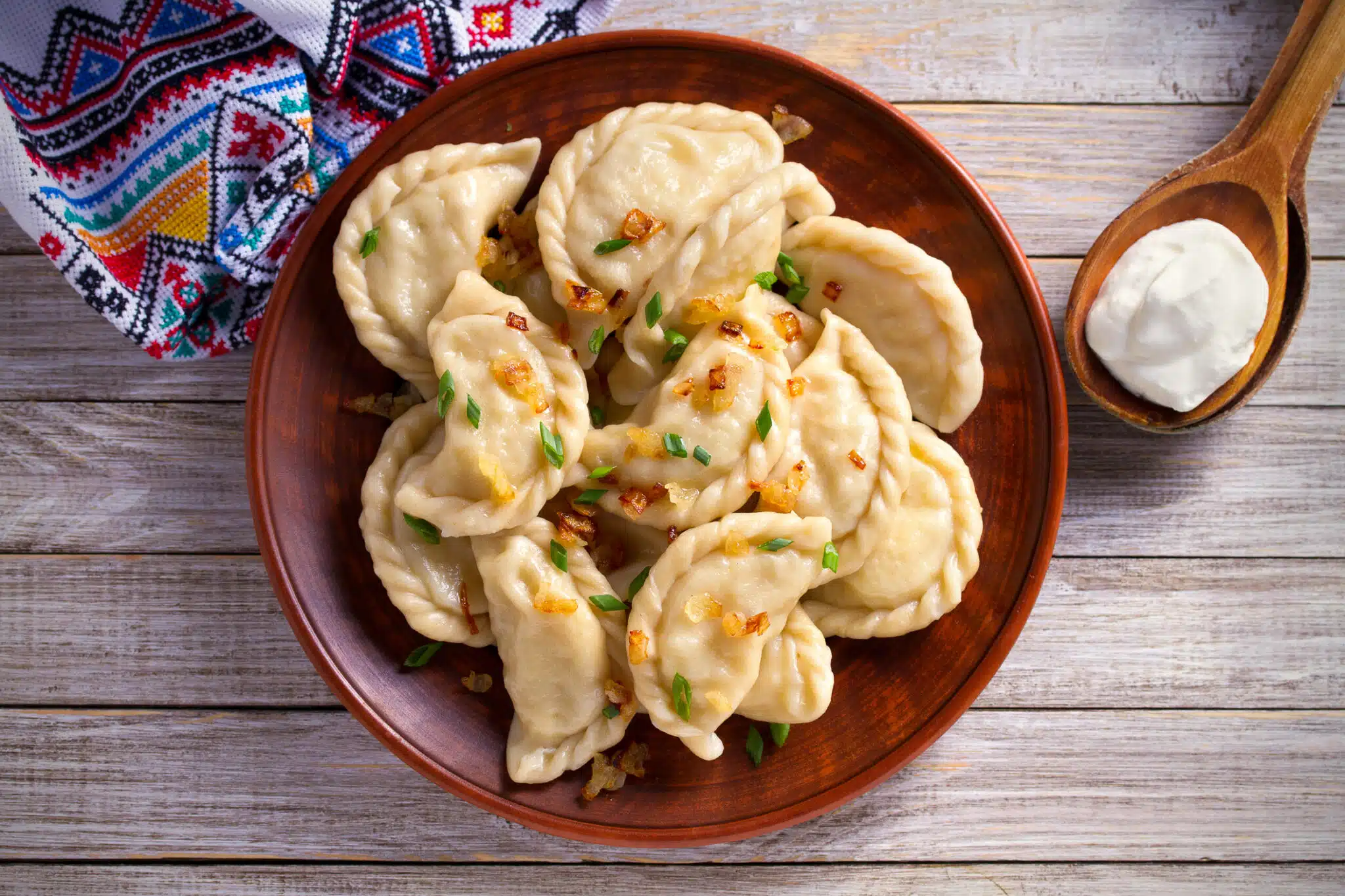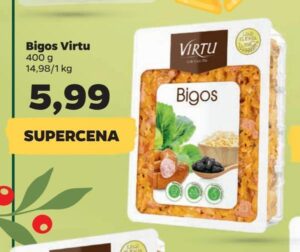Bigos, sometimes referred to as “Hunter’s Stew,” is a Polish dish comprised of slow-cooked meat, cabbage, and spices. There are many variations of this simple dish. Different meats such as pork, beef, and mutton in fresh, smoked, and/or sausage form can be used. Sauerkraut can be used instead of or with fresh cabbage. Red wine or madeira wine can be used to fortify its flavor, as can fruits such as apples, plums, and prunes. Mushrooms are optional.
Although bigos is almost universally recognized as a Polish national dish, it is still known and enjoyed in those lands once part of the mighty Polish-Lithuania Commonwealth including Lithuania, Ukraine, and Belarus. This warm, spiced, hearty stew is known for its ability to fill the stomach and nourish the body after a long day of labor or hunting.
Why It’s Called “Bigos”
Bigos holds an important place in Polish cuisine, with records of the stew dating as far back as 1682 in Stanisław Czerniecki’s Compendium Ferculorum and its actual history likely dating far earlier.
As with many old dishes that hold national significance, the etymology of bigos is contested. Often these contestations reflect the interests of the countries. For example, the term has been linked to the German verbs begossen and becken (archaic), meaning “doused/watered” and “to chop” respectively. Likewise, bigos has been linked to the old German word bîbôz (now Beifuss), meaning “mugwort,” which was a common medieval cooking herb. These claims reflect the cultural influence of the Ostsiedlung, a term used to refer to the long-term migration of Germans into Eastern Europe during the Middle Ages.
In its earliest mentions in the 17th century, bigos was a word that named a meal made from leftovers from past dishes. The Polish verb bigosować has historically meant to “chop something up with a sabre.” It is likely, then, that the term bigos referred to chopped ingredients, dominated by the cabbage and meat that were commonly used in many other dishes. These two main ingredients have further led others to believe that bigos is derived from a compound of the Latin bi, meaning “two,” and gos, derived from the Latin gusto, meaning “taste.”
Bigos, like many old national dishes, has also found its way into colloquial Polish expressions. For example, ładny bigos translates roughly as “a pretty kettle of fish” or “an awkward state of affairs.” Likewise, narobić bigosu means “to jumble something up” or “to make a big mess out of something.” This perhaps reflects the idea that stews were historically dishes made of a hodgepodge of ingredients, thrown into the communal pot as they became available.
Bigos has also made an appearance in higher art such as in the epic poem Pan Tadeusz by Poland’s national poet Adam Mickiewicz which devotes a few verses to lovingly recounting its ingredients, its hearty rural nature, and then describing how the hungry hunters attack and devour the dish once prepared.
How And When Bigos Is Eaten
Bigos was historically eaten as a hunter’s stew. After a day of hunting, meat would be added to a large cauldron, which often contained the remnants of the previous stew as well. Thus, its contents would cook hours or even days at a time. Other leftovers, especially from large celebrations, would also be added to the pot.
This concept of a “forever” stew was common in medieval households and taverns. The continual heat prevented the food from spoiling and killed bacteria from leftovers that were sometimes even scraped from individual plates. The slow cooking and diverse ingredients made the food delicious. The contents of the pot were often one of the cheapest menu items in taverns, but such dishes were also popular with the nobility.
Noble Polish hunters travelled with a batch of pre-prepared bigos sealed in a pot. Cooking it with the seal intact, when enough pressure built up, the lid would erupt with a “cheer,” which is why bigos is supposedly served “with a cheer.” Bigos was especially prized on cold, wintry evenings but the 19th century Polish food historian and journalist Lucyna Ćwierciakiewiczowa found that bigos was also often eaten as a first course at lunch, and even as a breakfast.
 |
 |
 |
 |
For more on Polish cooking keep exploring this site or try some of the great resources above!
In addition, there are a number of side-dishes that are served alongside bigos. The most common of these are proziaki (soda-breads rolls), kopytka (Polish gnocchi), and kluski śląskie (Silesian potato dumpling).
Bigos is often included as one of the 12 dishes that traditionally eaten for Christmas eve in Poland, in a vigil supper known as Wigilia. This supper is always vegetarian and thus the bigos eaten is much more a spiced saurkraut than the bigos eaten on most other days. Mushrooms and fruits are more likely to be added to help add substance and flavor to the dish.
How Do You Correctly Cook Bigos?
According to the Wielki Słownik Polsko-Angielski (1970), Bigos is described as a “dish of hashed sausage, pork and beef stewed in sauerkraut.” The Collins English-Polish Dictionary (2006) describes it as a “Polish dish made of sauerkraut, sausage and mushrooms.” From just these two differing entries it is clear that there are likely just as many variations of the dish as there are accounts of the dish’s etymology!
Today, the two most essential ingredients are meat and cabbage. Beyond that, imaginations can run wild. Beef, pork, hare, venison, boar and mutton have all been used, either by themselves or in conjunction; sweet or sour cabbage, sauerkraut, mushrooms and beetroot leaves have likewise lent themselves to the variations of the dish, of which there are a few well-known examples.
Regional variations also exist. Bigos litewski (Lithuanian bigos) is made with apples, bigos galicyjski (Galician bigos) with potatoes and white beans, whereas bigos węgierski (Hungarian bigos) is made with red pepper and sour cream.
Another version, bigos staropolski (Old Polish Bigos) is made with plums, mushrooms, and juniper seeds.
According to the Polish food blogger Karolina Klesta, bigos tastes best when eaten a few days after it has been cooked, and even better if it is fried before being served. Another optional trick is to avoid seasoning until right at the very end, due to the high salt content of sauerkraut and preserved meats.
Let’s Cook!
| Bigos Staropolski
Składniki na ok. 3 porcje:
Sposób przygotowania: 1. Grzyby wsypać do niedużego garnka i zalać 500 ml zimnej wody. Pozostawić na kilka godzin, a najlepiej na całą noc. 2. Namoczone grzyby ugotować w tej samej wodzie, w której się moczyły, aż będą miękkie. (Czas gotowania wynosi ok. 30 minut). Grzyby osączyć i pokroić w paski. Wywar z grzybów należy zachować! 3. Kapustę kiszoną wypłukać (ale tylko, jeśli jest bardzo kwaśna), osączyć, pokroić drobno i przełożyć do garnka. Zalać małą ilością wrzącej wody (tyle, aby woda pokryła kapustę) i gotować do miękkości pod przykryciem (ok. 1 godziny) 4. Kapustę białą oczyścić z zewnętrznych liści, poszatkować, zalać małą ilością wrzącej wody (tyle, aby woda pokryła kapustę). Posolić 1 łyżeczką soli i gotować do miękkości (ok. 30 minut). 5. Ugotowane kapusty odcedzić i połączyć w jednym garnku. Dodać pokrojone grzyby i wywar grzybny oraz przyprawy: ziele angielskie, pieprz, liście laurowe, nasiona jałowca i goździki. 6. Mięso pokroić w kostkę i podsmażyć na oleju na złoty kolor. Posolić. 7. Osobno usmażyć pokrojoną w kostkę cebulę z pokrojonym w kostkę boczkiem i kiełbasą. (Kiełbasę obrać ze skóry). Dodać do kapusty razem z mięsem. Dodać pokrojone w paski śliwki. Podlać winem. Garnek przykryć, pozostawiając małą szczelinę i gotować co najmniej 1 godzinę. Bigos po ugotowaniu przyprawić ewentualnie do smaku solą i pieprzem, pozostawić do ostygnięcia, a następnie odstawić w chłodne miejsce. 8. Przez kolejne 2- 3 dni bigos należy zagotować, pogotować przez kilka minut, jeśli byłoby za dużo płynu to go odparować i ponownie schłodzić. Bigos z czasem przechodzi smakiem i nabiera aromatu. Na trzeci dzień bigos jest gotowy do spożycia. Można go również zamrozić lub gorący przełożyć do słoików, zakręcić, pozostawić do ostygnięcia, wstawić do lodówki i spożyć do 2 tygodni. |
Old Polish Bigos
Ingredients for 3 portions:
Instructions: 1. Place the dried mushrooms in a small pot. Pour in 500ml of cold water. Leave for a few hours, or preferably overnight. 2. Boil the mushrooms until soft in the same water used to soak them (cooking time is approx. 30 minutes). Drain, and cut into strips. Save the leftover stock! 3. Rinse the sauerkraut if it is very sour, chop finely, and place in a pot. Pour enough boiling water to cover the sauerkraut and cook until tender (approx. 1 hour). 4. Take off the outer leaves of the white cabbage, chop, and pour enough boiling water to cover the cabbage. Season with 1 tsp of salt and cook until tender (approx. 30 minutes). 5. Drain the cooked cabbage, and combine in one pot. Add the sliced mushrooms, leftover mushroom stock, and the following spices: allspice, pepper, bay leaves, junipers seeds, and cloves. 6. Cut the pork into cubes, and fry in oil until golden. Season to taste. 7. In a different pot, fry the diced onion alongside the bacon and sausage (peel the skin off the sausage). Add this mix to the cabbage, as well as the pork. Add the sliced plums and wine, and cover with a lid, leaving a small gap. Cook for at least 1 hour. After cooking, season the bigos with salt and pepper, let cool, then set aside in a cool place. 8. Over the next 2 to 3 days, the bigos should be boiled for a few minutes. If there is too much liquid, reduce the stew down, then leave to cool. Bigos gains it’s flavor and aroma over time. On the third day, the bigos is ready to eat. It is also possible to freeze it, or to put it, still hot, into jars. Seal the jar, leave to cool, place in the fridge, and consume within 2 weeks. |
Our Favorite Bigos Videos
Below is an easy-to-follow English-language walk-through of a basic bigos recipe, guided by Chef John on his popular YouTube channel Food Wishes.
This video is short, simple and comprehensive, encompassing and explaining the basic ingredients and flavors of the stew.
Guided by Dariusz, this recipe walkthrough includes the addition of apples, tomatoes, and mushrooms.
You’ll Also Love

The Talking Polish Phrasebook
The Talking Phrasebook Series presents useful phrases and words in side-by-side translation and with audio files specifically geared to help students work on listening skills and pronunciation. Each entry below, divided by category, features an English word or phrase in the left column and its Polish translation in the right. In the center column for […]

Dictionary of Polish Food
Polish food is hearty, flavorful, and deeply rooted in tradition. It is also experiencing a revival, re-inventing itself in major Polish cities as the country celebrates its heritage and embraces the latest trends and inspirations from world cuisines. Today, while dishes like pierogi, kielbasa, and bigos (hunter’s stew) are one you must try while visiting […]

Maslenitsa, Masliana, Meteņi: Spring Holidays of the Slavs and Balts
Rites of welcoming spring and saying goodbye to winter are some of the oldest holidays preserved across Slavic cultures. In the Baltics, the celebrations were nearly lost after being suppressed by Catholic and imperial dominance. Today, Russia’s Maslenitsa is by the far the best-known, but multiple versions exist across the diverse Slavic landscape. In the […]

Pierogi, Pīrāgi, Varenyky: A Tour of Pastries and Dumplings
The dumplings and pastries of Europe’s northeastern flank have a story to tell. Their recipes, etymologies, and related traditions are intertwined in a complex historical knot. There are so many ancient connections that it is almost impossible to say which influenced the next. And yet, each dish is held up as a unique and integral […]

Polish Holidays 2025: A Complete Guide
Polish holidays are heavily steeped in Catholic tradtion. They all have a distinctly Polish flair to them, however, in their foods, colors, and celebrations. Note that in Poland nearly everything closes for public holidays! Everyone will be celebrating! Find out more about Polish holidays, their history, cultural significance, and related days off below. Days Off […]








